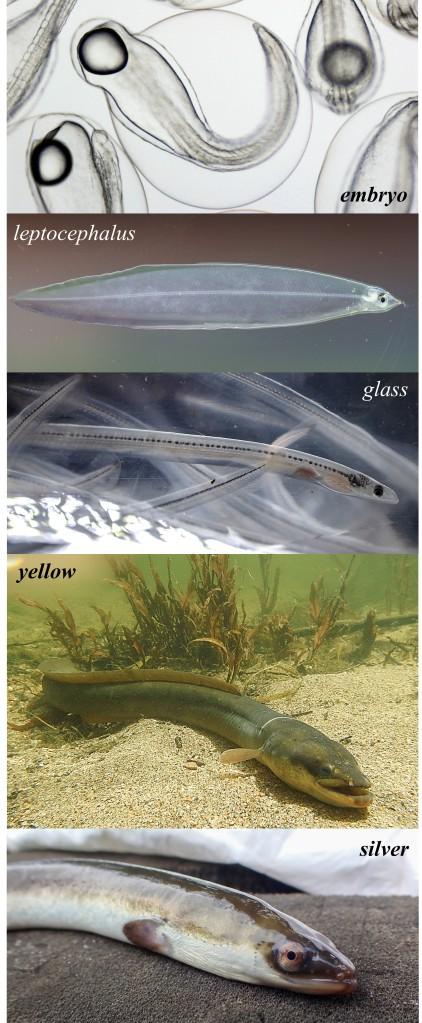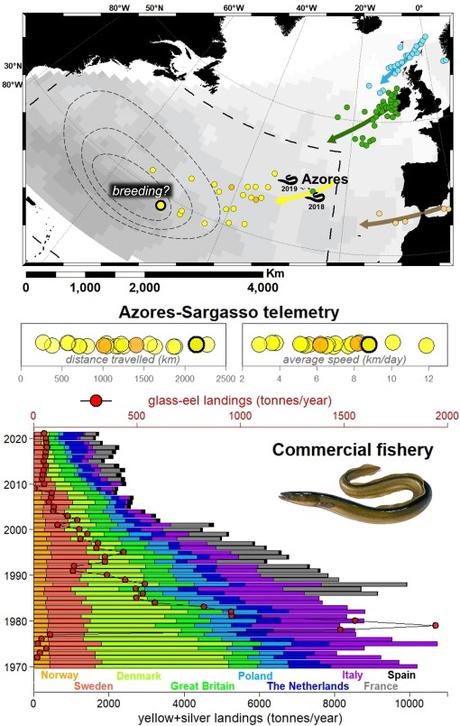The way that eels migrate along rivers and seas is mesmerising. There has been scientific agreement since the turn of the 20th Century that the Sargasso Sea is the breeding home to the sole European species. But it has taken more than two centuries since Carl Linnaeus gave this snake-shaped fish its scientific name before an adult was discovered in the area where they mate and spawn.
Even among nomadic people, the average human walks no more than a few dozen kilometres in a single trip. In comparison, the animal kingdom is rife with migratory species that traverse continents, oceans, and even the entire planet (1).
The European eel (Anguilla anguilla) is an outstanding example. Adults migrate up to 5000 km from the rivers and coastal wetlands of Europe and northern Africa to reproduce, lay their eggs, and die in the Sargasso Sea — an algae-covered sea delimited by oceanic currents in the North Atlantic.

As larvae emerge, they drift with the prevailing marine currents over the Atlantic to the European and African coasts (2). The location of the breeding area was unveiled in the early 20th Century as a result of the observation that the size of the larvae caught in research surveys gradually decreased from Afro-European land towards the Sargasso Sea (3, 4). Adult eels had been tracked by telemetry in their migration route converging on the Azores Archipelago (5), but none had been recorded beyond until recently.
Crossing the Atlantic
To complete this piece of the puzzle, Rosalind Wright and collaborators placed transmitters in 21 silver females and released them in the Azores (6). These individuals traveled between 300 and 2300 km, averaging 7 km each day. Five arrived in the Sargasso Sea, and one of them, after a swim of 243 days (from November 2019 to July 2020), reached what for many years had been the hypothetical core of the breeding area (3, 4). It is the first direct record of a European eel ending its reproductive journey.
Eels use the magnetic fields in their way back to the Sargasso Sea and rely on an internal compass that records the route they made as larvae (7). The speed of navigation recorded by Wright is slower than in many long-distance migratory vertebrates like birds, yet it is consistent across the 16 known eel species (8).

Wright claimed that, instead of swiftly migrating for early spawning, eels engage in a protracted migration at depth. This behavior serves to conserve their energy and minimises the risk of dying (6). The delay also allows them to reach full reproductive potential since, during migration, eels stop eating and mobilise all their resources to swim and reproduce (9).
Other studies have revealed that adults move in deep waters in daylight but in shallow waters at night, and that some individuals are faster than others (3 to 47 km per day) (5). Considering that (i) this fish departs Europe and Africa between August and December and (ii) spawning occurs in the Sargasso Sea from December to May, it is unknown whether different individuals might breed 1 or 2 years after they begin their oceanic migration.
Management as complex as life itself
The European eel started showing the first signs of decline at the end of the 19th Century (10, 11). In 2008, the species was listed as Critically Endangered by the IUCN, and its conservation status has since remained in that category — worse than that of the giant panda (Ailuropoda melanoleuca) or the Iberian lynx (Lynx pardinus).
The main threats the species faces include overfishing, climate change (for instance, changes in current patterns due to global warming), habitat loss and degradation in rivers and wetlands, water pollution, and artificial barriers that obstruct eel migration and prevent them from reaching habitats along their home rivers.
Thus, from the 19th Century, the distribution of European eels in the Iberian Peninsula has decreased by 80% due to the presence of obstacles (12). Hydroelectric dams not only block eel movements, but their turbines cause direct mortality of many individuals (13).
Subsistence fishing of European eels began in the early 20th Century, spreading from Germany and Scandinavia to the Mediterranean countries, while the large-scale fishing industry of glass eels was already high in the 1960s (11). Catches have since plummeted to today’s historical minimum (10).

The term anguleros refers to people walking the river banks and beaches of Euskadi catching angulas (glass eels) at night with the sole equipment of a wooden sieve and a lamp. Basques pioneered this traditional activity in the Iberian Peninsula and have practiced it for centuries; in fact, for many decades, cooking and eating angulas was exclusive to the Basques. Historically, angulas have been regarded as a food delicacy and the most reputed of all was, and is, caught in the Estuary of Bilbao and the stretch of the Oria river by the Aguinaga suburb in Usurbil (21).
Prior to the industrialization of the Basque Country in the 1950s, the rivers Artibai, Bidasoa, Deba, Oria and Urumea, and the Estuary of Bilbao, were the main fishing areas for angulas, while many were traded from the French Atlantic coast (> 250 t only in Donostia in 1930) to meet market demand. So, throughout the 1970s, many towns in Gipuzkoa built seawater premises to store live angulas imported from elsewhere for sale locally.
The rise in market demand has gone hand in hand with the decline in angula populations in Basque rivers in response to habitat degradation and overfishing. Angula fishing faded away in Euskadi over the course of the 20th Century. Although no accurate statistics exist, experienced fishermen claim that there are fewer angulas and fewer anguleros today than thirty years ago. Unfortunately, angulas are no different from other traded wildlife whereby scarcity drives increased market price and demand which, in turn, boost further harvesting and extinction risk — the so-called anthropogenic Allee effect (22).
Angula fishing techniques remain a traditional activity. Yet few fishermen master the art of a la ola (on the wave) fishing with their sieves and lamps, and fishing from boats is no longer based on rowing but powered by outboard engines — watch video in Spanish here by Basque Research Centre AZTI. Specialising in marine environments and food, this center aims “to contribute to a healthy, sustainable and whole society” through science-grounded products and technological innovation. AZTI is the Spanish representative in the ICES Working Group on Eels and the scientific advisor to the Basque and Spanish governments on the assessment and management of eel stocks. Together with other partners of the SUDOANG project, AZTI has developed the interactive tool VISUANG for the visualisation of eel-status indicators and obstacles to free movement.
Photos by AZTI (top to bottom): angula fishing from a boat equipped with circular sieves in the Oria Estuary (Gipuzkoa), fisherman catching angulas with an oval-shaped sieve along the shore of the River Butrón (Biscay), and six angulas caught in a sieve along the Plentzia beach (Biscay) — Basque Country, Spain.
CITES listed the species in Appendix II in 2009, arguing that international trade contributes to the over-exploitation of eel stocks. CITES then encouraged exporting countries to provide the so-called non-detriment finding, whereby national scientific authorities should guarantee that proposed trading will not be detrimental to the persistence of the species in the wild.
The European Union was unable to demonstrate this and, as a result, eel imports and exports have been banned since December 2010 (14, 15). However, high market prices encourage a massive illegal trade, particularly to Asia where one kg of glass eel is worth over €6000 (16) — see why in this video documenting the intricacies of artisanal fishing and marketing in Northern Spain.
The management of the species is complicated (watch why here) because of its complex life cycle. Larvae and adults move along rivers, wetlands and coastal and open marine waters through many countries. Management and conservation actions, however, are taken at the national and regional levels as though the species consisted of isolated populations.
Consequently, the European Union mandated the creation of national management plans for its member states in 2007 (Directive CE1100/2007), but the species has shown no signs of recovery (15). The International Council for the Exploration of the Sea (ICES) has advised (full report here) closing down the entire fishery in 2023, including all forms of fishing (commercial, recreational, glass-eel captures for restocking and aquaculture) (17).
It is urgent that we keep restoring water quality and habitat connectivity between the heads and tributaries of European rivers, at least by removing dams that have been abandoned. The preservation of the species will solely be possible if all countries and regions, through which this fish travels, take coordinated actions against threats and adhere to scientific advice.
Salvador Herrando-Pérez & Estíbaliz Díaz
This blog post is an extended version of the article in Spanish published in volume 446 of the magazine Quercus (April 2023)
References
- Alerstam T, Hedenström, A & Åkesson, S (2003). Long-distance migration: evolution and determinants. Oikos 103: 247-260
- Baltazar-Soares M et al. (2014). Recruitment collapse and population structure of the European eel shaped by local ocean current dynamics. Current Biology 24: 104-108
- Schmidt J (1923). Breeding places and migrations of the eel. Nature 111: 51-54.
- Miller MJ et al. (2019). Spawning by the European eel across 2000 km of the Sargasso Sea. Biology Letters 15: 20180835
- Righton D et al. (2016). Empirical observations of the spawning migration of European eels: the long and dangerous road to the Sargasso Sea. Science Advances 2: e1501694
- Wright RM et al. (2022). First direct evidence of adult European eels migrating to their breeding place in the Sargasso Sea. Scientific Reports 12: 15362
- Durif CMF et al. (2013). Magnetic compass orientation in the European eel. PLoS ONE 8: e59212
- Béguer-Pon M et al. (2018). Tracking anguillid eels: five decades of telemetry-based research. Marine and Freshwater Research 69: 199-219
- Righton DA & Metcalfe, JD, in Encyclopedia of Fish Physiology: From Genome to Environment, AP Farrell, Ed. (Elsevier, 2011), pp. 1937-1944
- Podda C et al. (2021). Hard times for catadromous fish: the case of the European eel Anguilla anguilla (L. 1758). Advances in Oceanography and Limnology 12, doi:10.4081/aiol.2021.9997
- Dekker W (2019). The history of commercial fisheries for European eel commenced only a century ago. Fisheries Management and Ecology 26: 6-19
- Clavero M & Hermoso, V (2015). Historical data to plan the recovery of the European eel. Journal of Applied Ecology 52: 960-968
- Hanel R et al. (2019). Research for PECH Committee – Environmental, social and economic sustainability of European eel management. European Parliament, Policy Department for Structural and Cohesion Policies, Brussels: 1-187
- ICES (2022). Joint EIFAAC/ICES/GFCM Working Group on Eels (WGEEL). ICES Scientific Reports 4: 1-205
- Righton D et al. (2021). Important questions to progress science and sustainable management of anguillid eels. Fish and Fisheries 22: 762-788
- Richards JL et al. (2020). Prevalence of critically endangered European eel (Anguilla anguilla) in Hong Kong supermarkets. Science Advances 6: eaay0317
- ICES (2022). Advice on fishing opportunities. Report of the ICES Advisory Committee (03/11/2022)
- Tsukamoto K, Aoyama, J & Miller, MJ (2002). Migration, speciation, and the evolution of diadromy in anguillid eels. Canadian Journal of Fisheries and Aquatic Sciences 59: 1989-1998
- Grassi GB & Lankester, ER (1897). The reproduction and metamorphosis of the common eel (Anguilla vulgaris). Proceedings of the Royal Society of London 60: 260-271
- Sørensen SR et al. (2016). Ontogeny and growth of early life stages of captive-bred European eel. Aquaculture 456: 50-61
- Navaz JM (1964). Historia de una angula que se convirtió en angula. Sociedad de Oceanografía de Guipuzcoa, Spain: 39 p
- Courchamp F et al. (2006). Rarity value and species extinction: the anthropogenic Allee effect. PLoS Biology 4: e415

